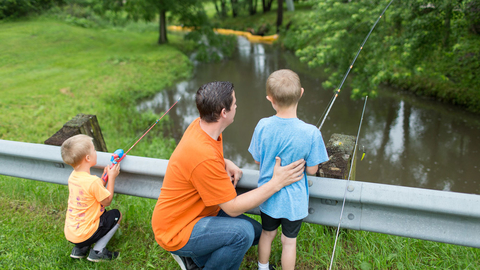As we celebrate Earth Day, it is good to reflect on how access to the outdoors enriches visitors’ and residents’ experiences within a community. Spending time in nature is key to inspiring environmental conservation efforts. Access to those experiences can vary widely, depending on equipment, green space availability, economic factors, and more.
Community tourism and economic development practices can highlight opportunities for sustainable business development and proper management of natural resources. Opportunities for shared thriving and wellness emerge when communities not only consider visitor experiences but also seek ways to connect residents to natural resources in their own communities.
Public green spaces
When thinking about barriers to natural environments or outdoor recreation, it can be easy to picture hard-scape environments, devoid of trees or grass. Especially vulnerable are communities or development projects that have not had green spaces included in development plans. Some of these structural differences may have happened accidentally. While other planning decisions were part of historic redline policies — the effects of which reverberate today.
Ordinances and building regulations or lack thereof created neighborhoods with structural barriers to green spaces. Examples include Frogtown in St. Paul, a neighborhood platted with the least green space in the city, and Cedar-Riverside in Minneapolis, isolated by freeways from the wealth of Minneapolis city parks and trails.
Projects like the Frogtown Farm have grown out of community efforts to add green spaces and connections to the outdoors, while also serving as a catalyst for relationships. While certainly present in urban core areas, neighborhoods and commercial developments without connections to green spaces are readily found in smaller towns and cities as well.
Eco-friendly landscape and infrastructure
Regardless of the size of the community, the ability to walk safely to parks and natural spaces, slow water run-off to protect water quality, and view the night sky are universal concerns. Permitting processes may be one of the only times a community has to address the long-term impact a built landscape has on human well-being.
Developers often balk at the added expense of planning for trees, playgrounds, and sidewalks as part of development approval processes, but they are important to community development. Trees and plantings help prevent heat islands through their shade. They also stabilize soil, preventing erosion and protecting water quality. Lighting-plan illustrations detail fixtures directing their beams toward doors and entries, while also limiting light pollution that impacts insects, birds, and obscures the stars.
Environmental investments serve near-term community concerns and also support the infrastructure and experiences sought out by visitors.
Accessible locations and resources
Beyond the concrete and asphalt that may initially come to mind, natural spaces can also represent barriers to access. Across the state, communities boast of the beauty of their waterways and lakes, yet to a resident without a boat or lake property, there may be no way to enjoy that public resource. Residents living and working in prime tourism locations may lack the paid time off to afford to visit them.
Access to recreational vehicles such as quads and snowmobiles requires at a minimum, adequate credit to cover liability fees for renting equipment. It also requires the ability to purchase the equipment, means to transport it, and store gear off-season.
Community-based solutions
Addressing these barriers has the potential to transform connections to nature and to stewarding natural resources.
Access to the outdoors has been created through innovative programs that often leverage relationships and assets already present, and examples abound. One such example is found in Waseca, where the Community Education program partnered with the Parks and Recreation department to check out kayaks and other equipment on the shores of Clear Lake. Combining efforts among organizations has built recreational opportunities for residents and visitors. It is also building the relational resilience between important community organizations.
Other projects are more complex and require technical support, such as estimating the economic impact of a potential city-owned campground in Fairmont, Minnesota. In this study, Fairmont requested support to guide their planning and decision process. Community Economics experts leveraged data from the Tourism Center, and together, the researchers completed the study and informed the community’s decision. Addressing a community’s needs from a holistic perspective balances the goals of supporting economic viability with sustainability.
Tackling existing gaps in access to the outdoors requires commitment from many partners, reaching beyond the tourism sector. The practice of community tourism development is especially powerful when those relationships build connections with natural resources and outdoor recreation. Asking questions that push beyond profitability allows for:
- Structural barriers to be addressed.
- Connections between industries to emerge.
- Most of all, opportunities to build relationships between people.
Together, we can build communities that are inviting to visitors, while also being healthy for residents and the environment.


